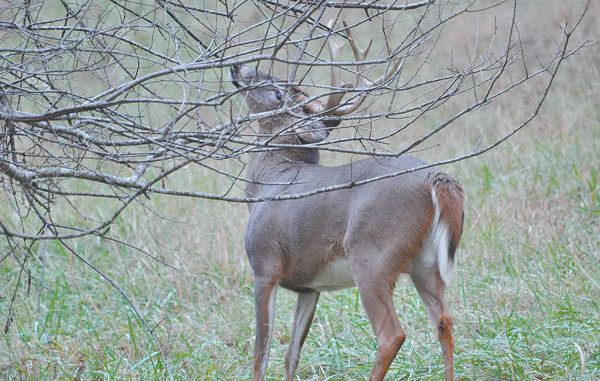
A Piedmont deer hunter leaves no stone unturned when it comes to managing for trophy whitetails — and killing them with a bow.
Whether or not you’re a country music fan, the message of Kenny Chesney’s song applies to many activities, particularly deer hunting.
Or, as Sean Connery said the Kevin Costner’s Eliot Ness character in the movie “The Untouchables” — “What are you prepared to do?”
Many hunters would love to harvest a wallhanger buck and eventually tire of shooting 110- to 130-inch deer. To change that outcome, they must answer one question: Are they willing to put in the time and effort to produce the desired results?
In North Carolina, — or anywhere — this goal can be accomplished several ways, but only one of which has much chance of success:
• A hunter could decide only to hunt places with trophy bucks. But as David Morris, the creator of North American Whitetail magazine once said at a Dixie Deer Classic seminar: “A hunter has to go where there are actually trophy deer before he’ll have a chance to kill a monster buck … that’s why if I wanted to kill a trophy buck, it wouldn’t be in North Carolina.”
Morris can afford to talk. He has the money to hunt in Canada, Texas, Mexico and Wisconsin. That kind of cash and time isn’t available to 99.9 percent of the rest of us. But Morris may have been wrong about North Carolina’s trophy potential.
• A hunter could decide to hunt every day, thus increasing his chances to encounter a big whitetail. But once again, he’d run into the availability problem, not to mention putting his job in jeopardy unless he’s independently wealthy. So the amount of time spent in the woods — unless directed at getting the drop on a particular buck that makes one’s hair stand up — probably won’t be successful, unless a hunter has a horseshoe in his pocket. But that’s the way most North Carolina hunters are forced to tackle the problem.
• Cheating. That, unfortunately, is the approach of some people. Fire-lighting and road-hunting are two ways this is done, but neither practice is ethical or legal, and both are likely to put practitioners in legal trouble. Neither activity, by the way, can be considered “hunting.” Some people also discover where big bucks are at someone else’s land and try to slip in shoot a big buck. Again, that’s unethical and asking for legal trouble.
But there’s apparently another way to increase your chances of decorating a wall with trophy deer heads.
Eddie Dunnagan of Durham has been willing to pay the price for trophy bucks the past 10 years.
“I’ve got several 130-class bucks on my walls,” he said, “but I got to where I wasn’t interested in putting any more up there.”
Dunnagan, 45, a district line-crew supervisor for Progress Energy, also farms, and he practices wildlife management — to some degree — on the land he cultivates.
His second business, Advantage Outdoors (919-667-4636), is about helping landowners, clubs or leaseholders manage their properties for quality whitetails and other wildlife. He personally manages and hunts farms in Caswell, Durham, Granville, Orange, Person and Wake counties.
“All (the farms) are managed to a certain degree, including harvest restrictions,” he said. “Four of the locations have intense management, with protein mixes, minerals, food plots, and corn feeders that feed all year round.”
At several of his farms, Dunnagan has seen his labors pay off in big-buck dividends.
“You’re not going to believe this, but you know people talk about how a 2-to-1 does-to-bucks ratio is good for a whitetail deer herd?” he said. “I’ve probably got a 2-to-1 bucks-to-does ratio at some of my properties.”
What’s his secret? Simply put, food. Providing nutrition and plenty of it are the keys to Dunnagan’s success.
“I have food plots of ladino clover, which works as an attractant and for nutrition,” he said. “I plant (Advantage Outdoors) Buck Wild Oats for winter nutrition, and soybeans, which is an attractant.”
He has acres and acres of corn that he uses in his feeders and sells to other hunters, and he also feeds deer protein mixes — varying amounts depending upon the time of year — plus mineral salt stations and Lucky Buck attractant.
As for management tactics, Dunnagan has some definite ideas.
“I don’t care what anyone says; there are two other critical aspects (to growing trophy bucks) — a good sex ratio (male to female) in your herd and the ages of your bucks,” he said. “Those are two things you must have.”
To get a good sex ratio in his deer herds, Dunnagan removes lots of does.
“When you think you have (taken out) enough (does), harvest more,” he said.
For bucks, he takes a different approach.
“Let ’em grow to a minimum of 4½ years old,” he said.
A common mistake hunters make is seeing a decent rack and shooting bucks with the potential to become wall-hangers.
“Don’t try to judge (bucks) by their antlers,” Dunnagan said. “Use the neck-to-chest transition, high or low (chest depth) lines to determine their age. Ninety percent of the bucks in this state never reach more than 2½ years old.”
Older bucks have longer bodies, deeper chests, and their legs will look shorter than young bucks.
Dunnagan discounts Morris’ opinion of Tarheel State deer. North Carolina whitetails, he said, particularly in the piedmont, have the same genetic makeup that produces record-book racks in Midwestern states and Texas.
“We have the genetics and great trophy potential in this area of the country,” he said. “We just need to let our bucks mature. Most 8-pointers will reach Pope & Young size (125 inches typical; 155 inches non-typical), under the right circumstances, by the time they are 3½ years old.
“Hunters just need to have knowledge, commitment, patience and a little luck.”
His trophy-production didn’t happen overnight.
“I put over 10 years of time into the areas that I hunt today,” he said. “I have paid my dues and then some.”
Put the hammer down on poaching
The main opponents of any type of management plan for growing big whitetails should be fairly obvious — other people.
“I’ve had some real challenges in maintaining big deer at my properties,” Durham’s Eddie Dunnagan said.
One of those problems is that other hunters don’t have his high standards. The way most North Carolina hunters have been conditioned, it’s rare for someone to pass up a 135-inch buck.
“There’s nothing I can do about two of my biggest problems,” said Dunnagan, who has property where adjacent landowners don’t practice the same quality-deer management.
“It’s tough to see a buck I’ve nurtured for several years wander off my properties and have someone else shoot him when he’s 2½ years old,” Dunnagan said. “But that can’t be helped; it’s gonna happen.”
Another problem is automobiles.
“I’ve got roads near all my properties, and a lot of my deer get hit by cars and trucks,” he said. “It just makes you sick.”
Last year, he found a 15-month-old buck in a roadside ditch adjoining a parcel of his land. It’d been hit by an automobile.
“It weighed 160 pounds and was a full 8-pointer with a drop tine,” he said. “That deer, if it had lived, would have grown up to be something special.”
His final problem is poaching.
“Yes, I’ve had people trespass at my properties,” Dunnagan said.
The first time he apprehended someone on his property — which is posted with No Trespassing and No Hunting signs — Dunnagan said he tried to be reasonable.
“The first time I gave (the trespasser) a warning,” he said. “That didn’t work.”
Another individual poached a wild turkey on the same property and was caught by a local wildlife enforcement officer, who gave the trespasser/poacher three citations.
“People who own land around me now pretty much know I mean business,” he said. “I’ve got the cell numbers of all the local game wardens stored in my phone. They have always responded quickly when I call.
“If a person comes on my property now, he will be arrested. You have to do that to set an example.”
Dunnagan took four P&Y bucks in 2010
All the factors Eddie Dunnagan of Durham talks about came together in 2010, and he enjoyed his best year as a trophy hunter. In fact, he probably experienced the best year of any North Carolina hunter and perhaps had the best season of any bowhunter in the United States.
How many archers can claim four Pope & Young bucks in one season?
“I know I was extremely blessed in 2010,” he said. “It was truly the year of a lifetime for me.”
Dunnagan arrowed four bucks — two in North Carolina’s eastern deer section and two in the central section — each one of them a Pope & Young qualifier.
“I bowhunt almost all the time now,” he said. “I might hunt a day or two with my muzzleloader.”
Dunnagan dropped his first 2010 trophy on Sept. 11, the opening day of archery season. The main-frame 8-pointer had three abnormal points and scored 153 gross inches as a non-typical. The buck was 5½ years old and weighed 192 pounds.
His second buck, arrowed Sept. 19 on a horse farm, was a 10-pointer that gross scored 146¼. This deer was taken from a stand in a natural funnel between bedding area and a food source.
Dunnagan — who shoots a Mathews Switchback compound set at 68 pounds, Carbon Express arrows with vanes and Spitfire 100-grain Pro Series broadheads — nailed his third trophy the first week of October. It was a tall-racked, typical 8-pointer that scored just over 143 inches.
The fourth buck, a 10-pointer he nicknamed “Too Tall,” was brought down Oct. 30. The deer grossed 158 7/8 and netted 153 1/8 as a 4½-year-old. It was his largest taken to date.
Dunnagan, 45, is quick to point out he’s not an extraordinary deer hunter; he doesn’t know secrets for getting within bow range of trophy bucks, but he creates great habitat and food conditions for whitetails and never stops working to improve them.
If he were a golfer, he’d be classified a “grinder” — he never lets up, thinking year-round about how to attract bucks to his hunting territories and working to improve his land.
“I’ve got multiple stands, including Lamco (metal feed) stations that dispense only protein pellet mixes, mineral stations, acres of maintained food plots (chicory, red and white clover and winter forage), numerous plots of white clover plus feeders that dispense corn year-round and a few feeders that scatter corn, starting Oct. 1 and stopping Jan. 1,” he said.
Dunnagan doesn’t hunt around his feeding stations, just food plots that usually have automated corn feeders, staging areas and funnels.
“I like to hunt soybean patches that are next to my corn,” he said.
Dunnagan also has what he calls “sanctuaries” within his most intensely-managed property.
“They’re basically bedding areas I never go into for any reason,” he said.
He sets up trail cameras across his farms and has hundreds of photos of each area, so he knows the quality of the whitetails that inhabit his land.
“I had photos of (the 158 7/8 10-pointer) for three years,” he said. “I also had the sheds from this particular buck for the previous two years. Two years ago, he was a 135-class 9-pointer, then he turned into a 150-class 10-pointer last year.
“Everybody said you can’t manage for trophy deer at (relatively) small properties such as I have, places surrounded by houses, but I think I proved it can be done.
“People also say big bucks won’t come to (corn) feeders, but that’s not true if you maintain the food at a particular feeder. I think fawns and young deer get used to coming to a particular feeder with their mommas, and it becomes part of the forest to them.
“If you just stick a feeder up in some deer woods and don’t keep it full (of corn) all the time, you might not see trophy bucks coming to it that year or the next or the next. I think that’s just because the bucks are wary when something in their woods changes.”
Know what to plant to feed, hold whitetails
So how does Eddie Dunnagan prepare his land to plant crops that will grow big deer and keep them on his properties?
The first item to check is the pH of the soil (relative acidity).
“The best pH level for corn is from 5.8 to 6.5,” he said. “The best pH for clover is above 6.5. You can get free soil samples from your local agriculture agent.”
To increase pH level, ag agents can tell a landowner how much lime to add to his land each fall.
“The best attractant for any deer is beans and corn,” Dunnagan said. “I like LabLab, soybeans, and Pioneer Seed Corn.”
“I grow soybeans and corn together, but I fence the beans to keep deer out,” Dunnagan said. “Two weeks before bow season starts, I take down the fence and place a corn feeder in that plot.”
He said Imperial Whitetail is a popular clover for food plots, but he has a cheaper solution that works as well.
“(Imperial Whitetail) is a high-end ladino with a seed coating to help germinate quickly,” Dunnagan said, “but I buy Pinnacle ladino clover; it’s just as good and cheaper.”
Spraying for weeds and fertilizing clover patches also are necessities. Dunnagan fertilizes twice a year and overseeds clover patches each fall.
“Deer also like oats,” said Dunnagan, who uses Coker 228 oats, feeling they have a sweeter taste to deer.

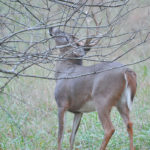
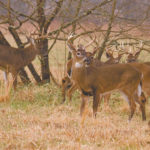
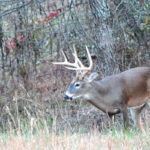
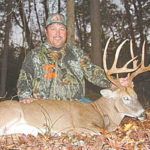
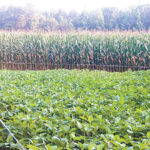
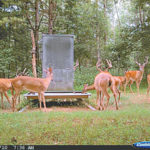



Be the first to comment